Author's posts
Jun 11 2012
Sunday Train: Putting Steel into the Amtrak Long Distance Backbone
Burning the Midnight Oil for Living Energy Independence
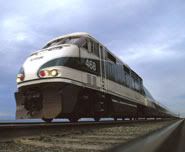 Express HSR is sexy. Indeed, its sexy enough that when Big Oil propagandizes against it, they have to paint it as too expensive or something that America is too incompetent to handle, since the idea of sitting in an actually comfortable rail seat, watching a movie on a laptop or snacking on a sandwich while flying along at two to three times highway speeds, “just like in France or Japan or Spain”, that’s too appealing to convince a big majority of people that it would be anything but nice to have. So they have to con people into thinking of it as an unrealistic pipe dream that the US can do what Spain has been doing for a decade, France for three decades, and Japan for half a century.
Express HSR is sexy. Indeed, its sexy enough that when Big Oil propagandizes against it, they have to paint it as too expensive or something that America is too incompetent to handle, since the idea of sitting in an actually comfortable rail seat, watching a movie on a laptop or snacking on a sandwich while flying along at two to three times highway speeds, “just like in France or Japan or Spain”, that’s too appealing to convince a big majority of people that it would be anything but nice to have. So they have to con people into thinking of it as an unrealistic pipe dream that the US can do what Spain has been doing for a decade, France for three decades, and Japan for half a century.
Rapid Rail is not as sexy as Express HSR, but at least it is as fast as driving for most drivers on most corridors, and appreciably faster than driving on the corridor with the “best bones”, like either Cleveland / Columbus or Davenport / Des Moines / Iowa wold be at 110mph top passenger speed. And it is much cheaper than Express HSR, with lots of potential corridors that local residents will start lobbying for once the first of the Rapid Passenger Rail services come into service.
But conventional long haul rail? Surely plodding along at 50mph to as slow as 30mph on heavy freight rail corridors is an obsolete holdover from an earlier time?
Well, no. Conventional long haul rail has a 21st century role to play, if the United States should declare Economic Independence and start working to regain the economic freedom that we surrendered to the Big Oil and the oil exporting regions in the 70’s and 80’s.
And so, in this evening’s Sunday Train, we look at the “PRIIA Section 210” plans that Amtrak has developed for the five weakest of its fifteen long distance corridors: the California Zephyr, the Capitol Limited, the Cardinal, the Sunset Limited, and the Texas Eagle.
Jun 04 2012
Sunday Train: Steel Interstates & An America That Can Do Big Things
Burning the Midnight Oil for Living Energy Independence
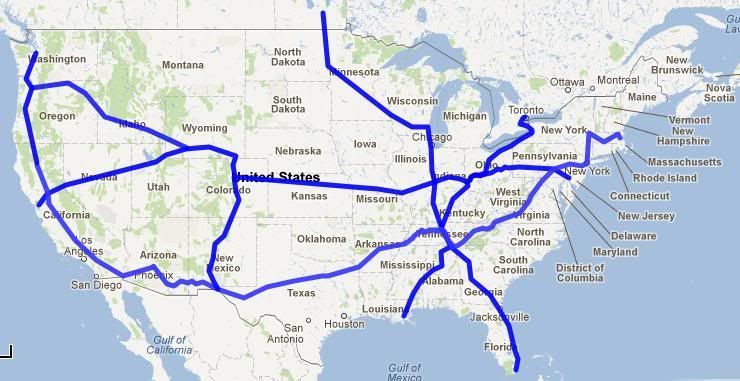 Steel Interstate (noun): A Network of Electrified Heavy and Rapid Rail corridors that will allow the United States to remain a sovereign national economy.
Steel Interstate (noun): A Network of Electrified Heavy and Rapid Rail corridors that will allow the United States to remain a sovereign national economy.
Integrated into the Steel Interstates are Electricity Superhighways to connect Renewable Energy Resource areas to each other, to substantially increase the stability of the available Renewable Energy Supply, and to Energy Consumers, to ensure that no rich Renewable Electricity Resource goes untapped for lack of access to a electricity markets.
This is something that the United States should do. Depending on the twists and turns of international energy markets in the coming decades, it may be something the United States must do, to remain a coherent national economy.
If the efforts of Big Oil and Big Coal are successful, it is the kind of thing that America will not be able to do.
Yet, I believe it is something that the United States actually can do.
May 27 2012
Sunday Train: Sustainable Steam Train? / SF Muni – HSR Disconnect? / A Geary Aerobus?
Burning the Midnight Oil for Living Energy Independence
 This week’s Sunday Train is a trio of shorter topics. The first is a research development project to develop a modern steam train to run on biocoal. The target is a sustainable steam train that, as a headline grabber, will attempt to run at 130mph and break the world steam train speed record. There’s much to like about this research development project … but I am going to argue that biocoal to operate trains is not it.
This week’s Sunday Train is a trio of shorter topics. The first is a research development project to develop a modern steam train to run on biocoal. The target is a sustainable steam train that, as a headline grabber, will attempt to run at 130mph and break the world steam train speed record. There’s much to like about this research development project … but I am going to argue that biocoal to operate trains is not it.
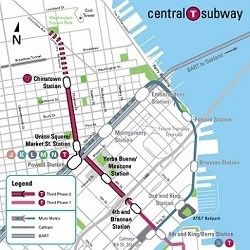 Second, SF’s MUNI transport agency is one of the ten agencies slated to split $760m in Prop1a(2008) bond funds improvements to systems interconnecting with the planned High Speed Rail system. The balance of the $950m goes to the three existing Amtrak California intercity rail services, the Capitol Corridor, the San Joaquin, and the Surfliner.
Second, SF’s MUNI transport agency is one of the ten agencies slated to split $760m in Prop1a(2008) bond funds improvements to systems interconnecting with the planned High Speed Rail system. The balance of the $950m goes to the three existing Amtrak California intercity rail services, the Capitol Corridor, the San Joaquin, and the Surfliner.
Odd thing is, the proposal that SF MUNI is setting forward doesn’t actually connect to the proposed HSR system? What’s up with that, after the break.
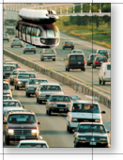 And third, a speculative look at an alternative technology that SF MUNI might deploy that money on, that actually would connect with the HSR system at the Transbay Terminal, as well as connecting to BART, the MUNI light rail network, the existing (and proposed alternative) Caltrain terminus at 4th and King, and provide express transit service along Geary Blvd.
And third, a speculative look at an alternative technology that SF MUNI might deploy that money on, that actually would connect with the HSR system at the Transbay Terminal, as well as connecting to BART, the MUNI light rail network, the existing (and proposed alternative) Caltrain terminus at 4th and King, and provide express transit service along Geary Blvd.
So instead of the traditional long trip, Sunday Train for Memorial Day Weekend has three short exursions. Join us for one, two, or all three, after the break.
May 20 2012
Sunday Train: Driving Ohio on Lake Erie
Burning the Midnight Oil for Living Energy Independence
Note: a reprint of a Daily Kos diary from Jan, 2007
There is a common trend in my part of the Great Lakes States (Ohio, Indiana, Michigan) for discussion of sustainable energy to focus on commercial exploitation of the Wind Resource of the Great Lakes.
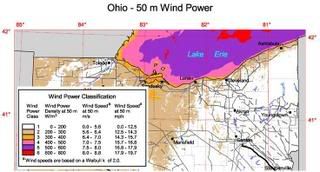 And why the Great Lakes? Because that’s where the wind blows, as shown on the trimmed down version of the 2004 50m wind speed map for Ohio to the right. The pink, purple and red are the highest quality wind resources. (jpg) And this is just 50 metres … at 100 metres it gets better still.
And why the Great Lakes? Because that’s where the wind blows, as shown on the trimmed down version of the 2004 50m wind speed map for Ohio to the right. The pink, purple and red are the highest quality wind resources. (jpg) And this is just 50 metres … at 100 metres it gets better still.
So what does this have to do with driving? Well, sometimes the wind blows harder, and sometimes the wind blows softer … and on this point wind power and driving snuggle right together with a whole bunch of Energy Independence posts I have already made. How things link together … is after the fold.
May 14 2012
Sunday Train: Faster Trains Yields More Services Per Day
Burning the Midnight Oil for Living Energy Independence
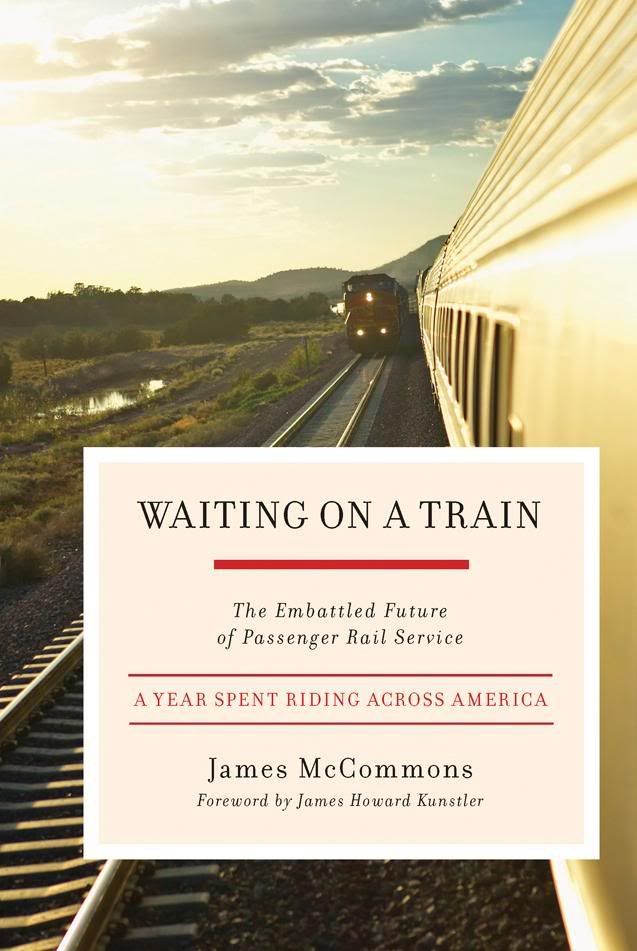 Back in the 29 Nov 2009 Sunday Train, Frequency and Waiting on a Train, I reacted to a point made in John McCommon’s book, Waiting on a Train:
Back in the 29 Nov 2009 Sunday Train, Frequency and Waiting on a Train, I reacted to a point made in John McCommon’s book, Waiting on a Train:
“Once those intermodal trains can go through Stampede Pass, it will take some traffic off the main line and free up more room for additional passenger trains,” said Uznanski.
By bringing the number of trains up to eight a day between Vancouver and Portland, ridership and ticket revenue will increase significantly. Currently ticket sales – what is known as farebox – cover 43% of the Amtrak Cascades’ operating expenses; the state subsidizes the remainder. Run eight trains daily, however, the farebox recovery goes up to 70%.
It’s all about frequency. When trains are frequency and convenient, ridership – particularly business travel – grows dramatically, said Uznanski.
It was a mantra I was to hear from experts all across the country – frequency builds ridership and only frequency significantly builds farebox recovery. Sure its great to have trains running more than 100mph in a corridor, but if there are only a couple of trains a day, they just aren’t convenient enough to move people off the highway or away from the airport.
– John McCommons, Waiting on a Train, Chelsea Green Publishing: Vermont, p. 51
This came back to mind when I was thinking last week about the “Cornhusker Rocket” proposal to reintroduce regular corridor service between Omaha and Chicago via Des Moines, Iowa City and the Quad Cities. Often times, a substantial benefit in getting train speeds up is that ability to operate more services per day with the same number of trains.
May 07 2012
Sunday Train: The Rock Island Line is a Mighty Fine Iowa Rapid-Rail Road
Burning the Midnight Oil for Living Energy Independence
 The Iowa Department of Transport has just completed the Chicago to Omaha Regional Passenger Rail System Planning Study, to select its preferred alignment for a detailed Environmental Impact Report.
The Iowa Department of Transport has just completed the Chicago to Omaha Regional Passenger Rail System Planning Study, to select its preferred alignment for a detailed Environmental Impact Report.
There were five alignments in the study, based on the five historical passenger rail services between Chicago and Omaha. From north to south, these are: the Illinois Central; the Chicago & Northwestern; the Milwaukee Road; the Rock Island Line; and the Burlington Line. The study also included one combined alignment, based on where the Burlington Line and the Rock Island Line cross in Wyanet in western Illinois.
The combined alignment is the one selected, taking the Burlington alignment out of Chicago, and then taking the Rock Island line to Moline in the Quad Cities on the Illinois / Iowa border and through Iowa City and Des Moines to Omaha (probably via Council Bluffs, but that has yet to be determined).
Apr 30 2012
Sunday Train: Leveraging HSR for a Fresno Regional Rail Corridor
Burning the Midnight Oil for Living Energy Independence
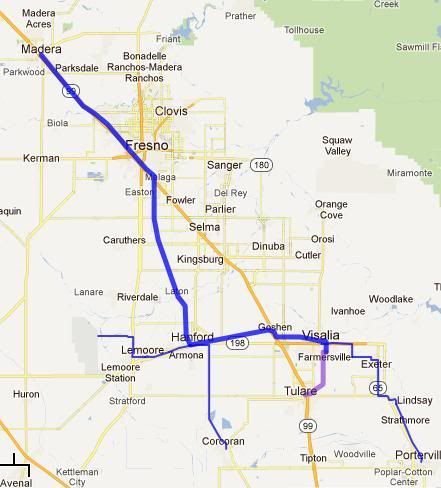 Kings County officials have been opposed all proposed routes:
Kings County officials have been opposed all proposed routes:
Board members said no high-speed rail route through Kings County would be acceptable while denouncing the Authority and its Fresno-to-Bakersfield environmental impact report.
“I think we should come out and oppose high-speed rail in Kings County, no matter what alignment they have,” said Supervisor Tony Barba during a discussion of the county’s official response to the EIR, which is due Thursday. He was applauded by a large crowd that nearly filled the Board of Supervisors’ chambers at the Kings County Government Center.
And then they opposed getting started on California HSR:
HANFORD – Kings County supervisors on Tuesday will likely ask three key legislators to delay high-speed rail funding until the project resolves local conflicts.
…
The Legislature is expected to vote in June whether to spend $2.7 billion in state bond money on the project, which has created major controversy in the San Joaquin Valley and stoked opposition from several cities and counties who believe it should be scrapped.Denying the funding would stop the Authority from starting construction in Fresno later this year or in early 2013.
And now, County officials seek to preserve Amtrak :
…
But Authority officials have recently entered into discussions with Kings County to see if Amtrak service through Hanford and Corcoran can be preserved, said Larry Spikes, Kings County administrative officer. Downtown stations are considered critical to cities’ local economy.Authority Board Chairman Dan Richard couldn’t be reached for comment.
“Taking Amtrak right out of the heart of Hanford and Corcoran is just not a good idea,” Spikes said.
So, don’t want the HSR Station in town, don’t want the HSR to go outside of town, and wants Amtrak to be continued to Hanford and Corcoran at slow speed when the San Joaquin after the high speed route between Merced and Bakersfield becomes available.
What I am looking in this week’s Sunday Train is a different way to go about this that provides a mix of local and intercity transport benefits to the major county centers: the Fresno Regional Rail Corridor.
Apr 26 2012
Romney Wants An Economy He Refuses to Make Possible
Burning the Midnight Oil for Progressive Populism
Romney indulged in soaring rhetoric{1} when he declared victory{2} in the fight to become the Republican Nominee and launched his General Campaign pitch:
I have a very different vision for America, and of our future. It is an America driven by freedom, where free people, pursuing happiness in their own unique ways, create free enterprises that employ more and more Americans. Because there are so many enterprises that are succeeding, the competition for hard-working, educated and skilled employees is intense, and so wages and salaries rise.
One problem: he refuses to make it possible. The success of new business enterprise requires customers with the means and willingness to buy, and productive workers, equipment and natural resources. Romney’s policies are:
- To take even more of the means from those with the willingness to buy to those who place a higher priority on accumulating wealth
- Offer his hypothetical entrepreneurs workers that are under-skilled and under-educated
- Saddle prospective entrepreneurs that attended college with a burden of debt
- Reduce the freedom of those workers with health benefits to take a job with that entrepreneur
- And insist on leaving all of those entrepreneurs exposed to the risk of the next oil price shock recession throwing them into bankruptcy
He expresses a desire for a wonderfully desirable economy, but his policies promise that his administration will be too damn lazy to lift a finger to it possible.
Heck, that could be a bumper sticker: “Vote Romney for a Lazy, Do-Nothing Government.”
That’s it. Nothing below the fold but notes.
Apr 23 2012
Sunday Train: Should Cap&Trade Funds finance the California HSR?
Burning the Midnight Oil for Living Energy Independence
 One element of the recent California HSR “revised” draft 2012 Business Plan (which we shall call the Other, Other Plan) involves looking to one particular means of finance in addition to general fund bond finance and Federal transport grant funding:
One element of the recent California HSR “revised” draft 2012 Business Plan (which we shall call the Other, Other Plan) involves looking to one particular means of finance in addition to general fund bond finance and Federal transport grant funding:
Cap-and-Trade Program Funds
Assembly Bill 32 (Statutes, 2006, Chapter 488) mandates a reduction of statewide greenhouse gas emissions to 1990 levels by 2020. In accordance with that law, California will implement a market-based cap-and-trade program. Funds from the program can be used to further the purposes of AB 32, including for development and construction of the high-speed rail system.
This has led to the current controversy in which the California Legislative Analysts Office, the LAO, has argued that the Cap and Trade funds might not be usable for HSR (pdf: p. 8).
One of their points, “Other GHG Reduction Strategies Likely to Be More Cost Effective,” involves a serious and common misframing of the question of the use of funds dedicated to reducing Greenhouse Gas Emissions: when reducing GHG emissions in a project that serves multiple purposes, the cost effectiveness of the GHG emissions spending depends on what share of the project funding is represented by that GHG emissions spending.
So more on transport, Green House Gas emissions, and the peculiar analytical weaknesses that crop up whenever the California LAO turns its attention to HSR, over the fold.
Apr 16 2012
Sunday Train: The Miami/Orlando Passenger Rail Project
Burning the Midnight Oil for Living Energy Independence
 I saw this story a couple of weeks ago, but between the happenings in California and some unanswered questions I had, I haven’t mentioned it yet. Florida East Coast Industries plans Miami-Orlando passenger service by 2014:
I saw this story a couple of weeks ago, but between the happenings in California and some unanswered questions I had, I haven’t mentioned it yet. Florida East Coast Industries plans Miami-Orlando passenger service by 2014:
Passenger train service between Miami and Orlando could begin as early as 2014 under a plan announced Thursday by Florida East Coast Industries.
The new “All Aboard Florida” service, which would be privately owned and operated, would offer frequent, regularly scheduled daily trains geared to business travelers and tourists. The Miami-Orlando trip by rail would take three hours, about the same time it takes by car via Florida’s Turnpike.
There would be four stops: Miami, Fort Lauderdale, West Palm Beach and Orlando, each with connections to airports, seaports and existing rail systems such as Tri-Rail and Metrorail. The trains would run on existing FEC tracks that stretch along the east coast from Miami to Cocoa. Forty miles of new track would link Cocoa to Orlando.
Well, waddya know ~ a Passenger Train that Rick Scott can’t kill. More about the Miami/Orlando Train, below the fold.

Recent Comments